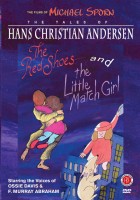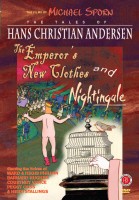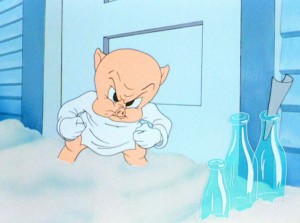Commentary &SpornFilms 19 Jun 2007 08:00 am
Show and Tell

 – Tomorrow, Wednesday, ASIFA East will have a program built around the two dvds we have in release this coming week.
– Tomorrow, Wednesday, ASIFA East will have a program built around the two dvds we have in release this coming week.
We’ll show clips from the four films featured on the dvds as well as a bit of the documentaries made for the discs. Masako Kanayama, Jason McDonald, Ray Kosarin and Stephen MacQuignon, all of whom were among those who helped make the films, will join me on the the stage to talk about the energetic little studio we had at the time that made the films in a very short period.
We’ll view the art styles that went into making the shorts and the various techniques we used in the making. I’ll bring some of the art to demonstrate.
If you’re in the New York area, I encourage you to join us for the evening. It’s free.
School Of Visual Arts
209 East 23rd Street
(Bet. 2nd & 3rd Ave)
5th Fl, Rm 502
7 PM
 A post I enjoyed this last week appeared on Eddie Fitzgerald‘s Uncle Eddie’s Theory Corner.
A post I enjoyed this last week appeared on Eddie Fitzgerald‘s Uncle Eddie’s Theory Corner.
The thesis Eddie presented is that inbetweens should be more integral to the animated extremes than mere inbetweens. Exact inbetweens of an animator’s work is essentially artless. A close breakdown of a great example, Rod Scribner‘s scene from Bob Clampett‘s Porky Pig short, Kitty Cornered, is given.
The problems occur (as many of those who commented on Eddie’s site stated) when an inbetweener – generally someone relatively new to the profession – is given free reign on an animator’s scene.
At Raggedy Ann, where I supervised NY’s assistants and inbetweeners, we had one novice erase Jack Schnerk’s roughs because she didn’t like the way they looked. The she repaired them and started inbetweening. Fortunately, we were able to reconstruct Jack’s scene and have the scene re-inbetweened.
At Fleischer’s studio in the thirties, for the first weeks of the job, inbetweeners were made to draw exact halves between two lines. Over and over and over and over and over.
Rod Scribner obviously had similar working methods that I was taught by Tissa David. Both qualify as straight-ahead animators. (This was initially the reasoning given for the rift between Ub Iwerks and Walt Disney that ultimately led to their early split.)
For those who don’t quite understand what I’m talking about, an Inbetweener by definition is hired to put missing drawings between two extreme drawings. An animator does drawings #1 & #5. The inbetweener draws #3, then inbetweens #2 and #4. A straight ahead animator would start with drawing #1 then continue forward until completion.
In fact, David and probably Scribner are more an amalgam of straight-ahead AND inbetween.
Tissa hates leaving drawings for an inbetween unless the process is forced on her or there is just too little time. However, working straight-ahead allows strange things to happen to the characters you’re animating. Going from drawing #1 to #2 to #3 etc. the drawings will subtly shift in shape until you can end with something very different by the time you reach the final drawing. Tissa tells the story of a dance scene where the character grew almost twice in size by the time she finished it. She then had to go back and redraw the entire scene, correctly sizing it.
She does very rough roughs for herself blocking the scene, leaving a large number of inbetweens. She then goes back and reworks the entire scene of completely new drawings (not clean-ups of her roughs) working straight-ahead UNLESS there are obviously mechanical inbetweens required. Then she’ll go back to do those inbetweens herself or hand them down to an assistant if available.
I assume Rod Scribner used a similar method. The drawings are too tight, especially the extremes for them to be otherwise. I wonder if there is a way to get inbetweeners to do the special inbetweens that Eddie longs for?
Certainly, they couldn’t be neophytes to animation, but would it make sense for anything less than an excellent assistant?
In my studio, I’ve tried to allow animators to work the way they like. They can work from the loosest of materials (sometimes just the rough storyboards we do) or the most exact of layout. I love it when animators do their own inbetweens, but some of my best animators over the years have required an assistant and an inbetweener. Doug Compton did some brilliant work with enormous vitality, and he definitely works with an inbetweener or five. John Dilworth, on my films, did some of the finest, most insightful character animation drawing his own inbetweens. Both of these guys are, now, excellent directors in their own right, both have similar but different methods of animation.
Eddie Fizgerald ‘s post has been quite thought provoking for me; I encourage you to take a look. Seeing the inbetween poses of that Porky scene is quite revealing. I may continue this with examples of my own. I know, for example, that Jim Tyer left inbetweens but it sure looks like he didn’t. Both Tyer and Scribner often did a more extreme kind of movement. I’m interested in the animators that worked a bit more quietly and did more interesting and expressive inbetweens themselves.

on 19 Jun 2007 at 11:59 am 1.Dave Levy said …
We, at ASIFA-East, are very proud to be showcasing the animation of Michael Sporn and his artists tomorrow night. I’ve been looking forward to this event all year. Please join us!
on 19 Jun 2007 at 4:30 pm 2.Eddie Fitzgerald said …
Thanks for the compliment and I certainly do hope you put up other examples. Talking about favorite scenes in detail isn’t just fan enthusiasm, it’s a way to provoke the writer into thinking more deeply about his subject.
I’d love to see an analysis of what you called quiet movement. It’s a real challenge to bring life to dialogue and subtle moments. Amazingly there’s not a lot written about this. There should be a whole book about it.
Good luck at the ASIFA event!
on 30 Jun 2007 at 7:05 pm 3.theresa said …
Hey, that’s great! I love my drawing on the cover!
